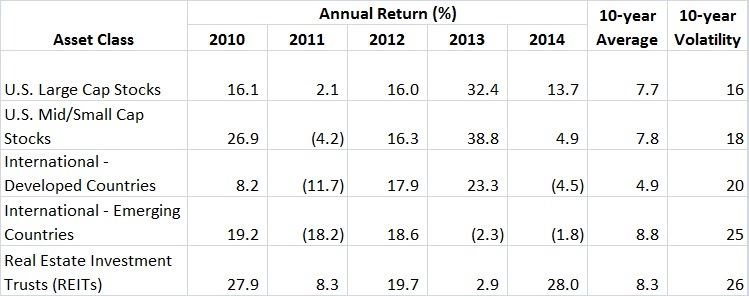
Photo by LendingMemo 
It is time to construct a diversified portfolio once you have decided the percentage of your portfolio that will be invested in stocks. But what is the best way to decide which funds to choose among the myriad of stock mutual funds and exchange traded funds available? The approach I outline below can be used regardless of whether the stock allocation in your portfolio is 40% or 90% of your overall portfolio. (A future post will consider how to construct the bond portion of your portfolio.)
Guidepost 1: Diversify Asset Classes
Experience shows that the key to successful investing is to own several different asset classes – different investment types with different characteristics – all of which are likely to yield positive long-term returns, but that do not move up and down together. In other words, broad diversification is important because in any year, one asset class will provide a better real return than another asset class. So it is best to have a portfolio that includes each of the available asset classes.
The chart below (source JP Morgan) shows the annual returns, the 10-year average return, and the assets classes’ volatility as measured by its standard deviation (a larger standard deviation means the average returns have greater peaks and valleys) for five stock asset classes.
Average Return By Equity Class (2010 – 2014)
The chart illustrates that a portfolio that is diversified across asset classes is less vulnerable to the impact of significant swings in performance by any one asset class. For example, in 2012 REITs performed best among the five classes but were outperformed by nearly every asset class the next year (2013). And as the chart shows, specialized asset classes, such as REITs and emerging markets, tend to be the most volatile as measured by their standard deviation, although they have had the greatest return from 2005 – 2014. This experience is why I believe that most investors are best served by allocations to investments that represent broad markets, such as U.S. and non-U.S. stocks.
Guidepost 2: Allocate According to the Market Capitalization of the Asset Class
Investors in the stock market must decide on the degree of exposure to the various risk and return characteristics appropriate for their objectives. For equities, these attributes include market capitalization (large-, mid-, and small-) and style (growth and value), and domestic and non-U.S. exposure. One approach to minimize your risk is to allocate your portfolio among assets classes according to the class’ proportion of overall market. In other words, emerging market stocks do not represent as big a percentage of the overall market as US large cap stocks, thus a balanced portfolio will hold fewer emergning market stocks. This proportional market capitalization approach ensures that the portfolio does not contain any more or any less risk than the overall market.
By market capitalization, international markets are a bit over 50% of the overall global equity market. Hence 50% would be the upper end of the percentage of your portfolio in international assets. According to research compiled by Vanguard, however, you can obtain the same degree of diversification with between 20% and 40% of your stocks in international funds.
Of the remaining non-international portion of your portfolio, large capitalization domestic stocks (e.g., big US companies) comprise about two-thirds of the domestic stock market and mid/small capitalization stocks comprise the remaining one-third. These percentages mirror the market percentages so that your portfolio would reflect each asset class’ proportional share of the overall market. To increase diversification further you could add real estate holdings to comprise 5% – 10% of your equity holdings.
An example of this proporationl market capitalization approach is below. If the overall portfolio has a 60% stock allocation (the other 40% is invested in bonds/cash), these two guideposts would suggest the following sub-class allocation:
- Domestic large cap funds (e.g., S&P 500): 24.6%
- Domestic small/mid cap funds (e.g., Russell 2000): 12.4%
- International funds developed countries: 12%
- International funds emerging markets: 6%
- Real estate: 5%
Once you have your asset class allocation, it is best to seek low-cost funds to achieve each of these investment allocations. Charles Schwab, Fidelity, and Vanguard all offer low-cost funds that track each of the market segments above for a brokerage account. And of course this approach can be used to allocate the funds in your retirement plan or college savings plan as well.
If you follow these guideposts you will have created a diversified portfolio in a manner that mirrors the risks and returns in the overall equity market.


No comments yet.